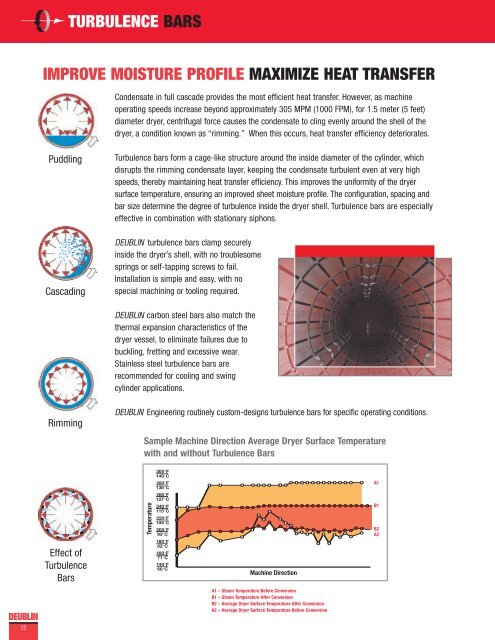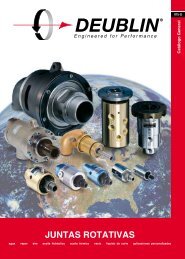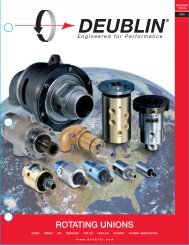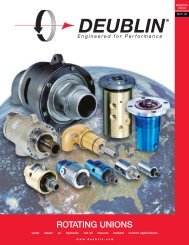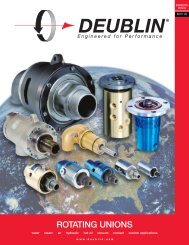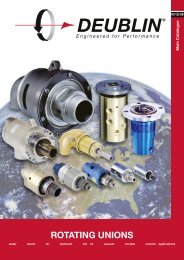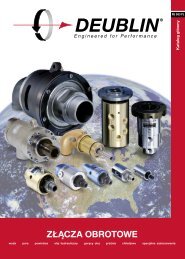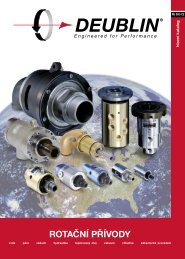ROTATING JOINTS AND SIPHON SYSTEMS - Deublin Company
ROTATING JOINTS AND SIPHON SYSTEMS - Deublin Company
ROTATING JOINTS AND SIPHON SYSTEMS - Deublin Company
Create successful ePaper yourself
Turn your PDF publications into a flip-book with our unique Google optimized e-Paper software.
DEUBLIN<br />
12<br />
Puddling<br />
Cascading<br />
Rimming<br />
Effect of<br />
Turbulence<br />
Bars<br />
TURBULENCE BARS<br />
IMPROVE MOISTURE PROFILE MAXIMIZE HEAT TRANSFER<br />
Condensate in full cascade provides the most efficient heat transfer. However, as machine<br />
operating speeds increase beyond approximately 305 MPM (1000 FPM), for 1.5 meter (5 feet)<br />
diameter dryer, centrifugal force causes the condensate to cling evenly around the shell of the<br />
dryer, a condition known as “rimming.” When this occurs, heat transfer efficiency deteriorates.<br />
Turbulence bars form a cage-like structure around the inside diameter of the cylinder, which<br />
disrupts the rimming condensate layer, keeping the condensate turbulent even at very high<br />
speeds, thereby maintaining heat transfer efficiency. This improves the uniformity of the dryer<br />
surface temperature, ensuring an improved sheet moisture profile. The configuration, spacing and<br />
bar size determine the degree of turbulence inside the dryer shell. Turbulence bars are especially<br />
effective in combination with stationary siphons.<br />
DEUBLIN turbulence bars clamp securely<br />
inside the dryer’s shell, with no troublesome<br />
springs or self-tapping screws to fail.<br />
Installation is simple and easy, with no<br />
special machining or tooling required.<br />
DEUBLIN carbon steel bars also match the<br />
thermal expansion characteristics of the<br />
dryer vessel, to eliminate failures due to<br />
buckling, fretting and excessive wear.<br />
Stainless steel turbulence bars are<br />
recommended for cooling and swing<br />
cylinder applications.<br />
DEUBLIN Engineering routinely custom-designs turbulence bars for specific operating conditions.<br />
Sample Machine Direction Average Dryer Surface Temperature<br />
with and without Turbulence Bars<br />
Temperature<br />
300°F<br />
149°C<br />
280°F<br />
138°C<br />
260°F<br />
127°C<br />
240°F<br />
115°C<br />
220°F<br />
105°C<br />
200°F<br />
93°C<br />
180°F<br />
82°C<br />
160°F<br />
71°C<br />
140°F<br />
60°C<br />
Machine Direction<br />
A1 – Steam Temperature Before Conversion<br />
B1 – Steam Temperature After Conversion<br />
B2 – Average Dryer Surface Temperature After Conversion<br />
A2 – Average Dryer Surface Temperature Before Conversion<br />
A1<br />
B1<br />
B2<br />
A2


